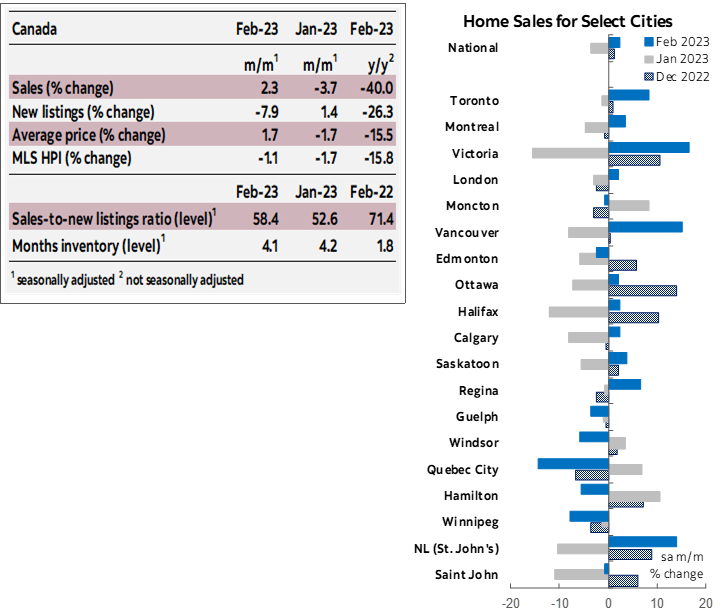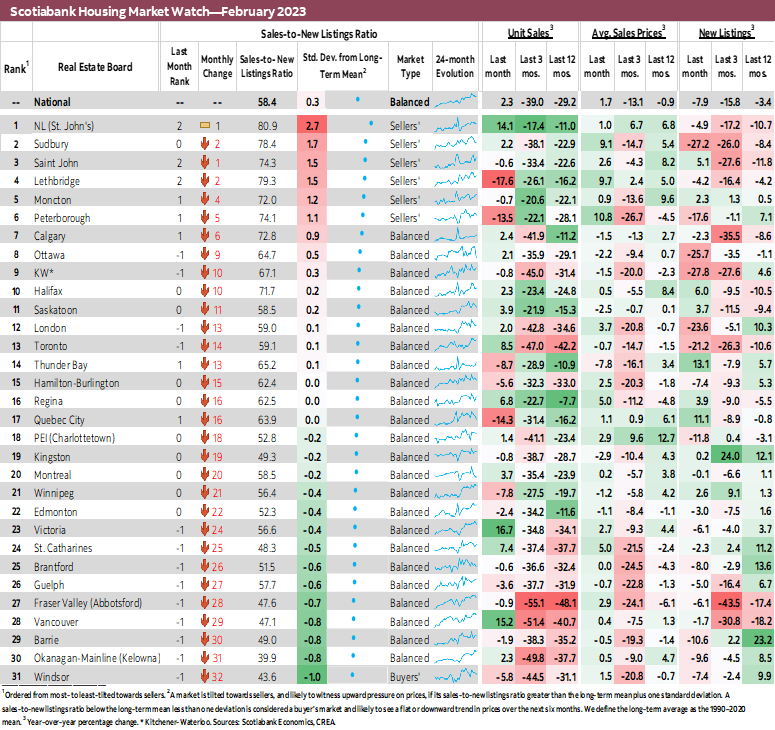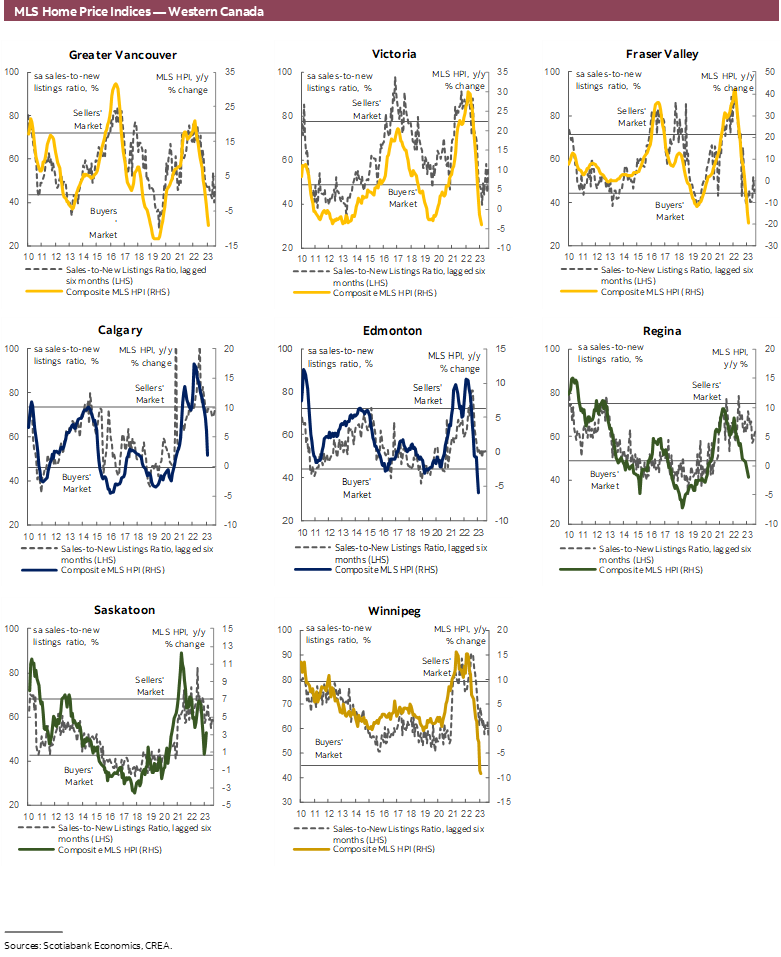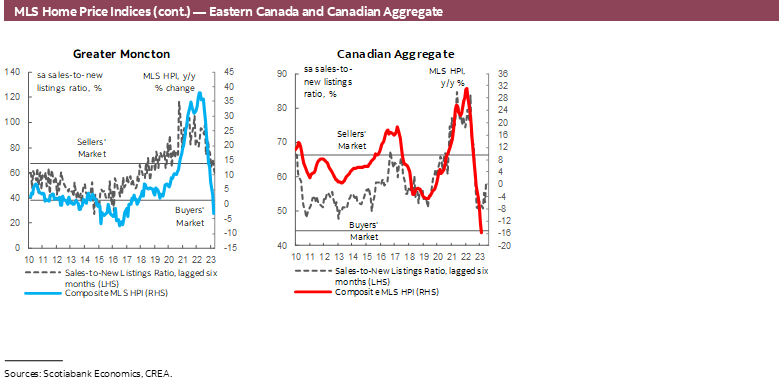CANADA HOUSING MARKET: SPRING WARMUP?
SUMMARY
Canadian home sales rose 2.3% (sa m/m) in February, despite a whopping 7.9% drop in listings. This month’s pullback in listings combined with a downward revision of the increase in the previous month pushed the sales-to-new listings ratio, an indicator of how tight the market is, to 58.4% — the tightest since last April and above the long-term average of 55.1%. However, the national housing market remained in balanced territory. Months of inventory reversed an easing trend that had been in motion since the fall of 2021, and edged down from 4.2 months in January to 4.1 months in February—a full month below its long-term average, but still a significant improvement from its all-time low of 1.7 months early 2022.
It was a fairly even split between markets that saw sales increase and those where sales declined, while the drop in listings was more widespread. Sales increased in 15 of the 31 local markets we track, with double-digit increases in Vancouver, Victoria, and St. John’s more than offsetting declines elsewhere. On the other hand, above 20% declines in listings in KW, Sudbury, Ottawa, London, and Toronto alongside double-digit declines in other centers dominated the increase witnessed in 9 of the local markets.
As a result, 24 out of the 31 local markets started the year in balanced territory, with 5 markets going back into balanced territory having been in buyers’ territory the previous month.
Prices continued to decline in February albeit at a much slower pace than previously. The composite MLS Home Price Index (HPI) edged down 1.1% (sa m/m), the smallest decline since April 2022, when it started trending downwards. This is also the first time since MLS HPI started trending downward that apartments have led the price declines (-1.5%) rather than the larger single-family homes segment (-1.2). With this month’s decline, the MLS HPI is now 16% below its February 2022 peak, but still 29% above pre-pandemic levels.
IMPLICATIONS
National home sales increased in February, and price declines slowed. While we will abstain from making any conclusions on the stage of the housing market correction based on this single month’s result, this seems to be inline with expectations of activity stabilizing. We will be monitoring the market as we enter the spring season, which should carry more information on the state of Canada’s housing market and signals about expected recovery.
The environment surrounding the housing market is evidently uncertain with the current turbulence in financial markets following the failure of two US banks and sticky US inflation further muddying the outlook for the Canadian and global economies. We remain of the view that the Bank of Canada will keep its policy rate at 4.5%, before gradually cutting rates through 2024 given our forecast of a mild recession this year and slowing inflation, with uncertainties posing significant risks to this rate call.
We still see some room for prices to continue to decline as part of the needed correction due to the lagged impact of higher rates along with government measures that came into effect in January. It is the case however that we believe most of the price declines have already taken place, since financial and borrowing conditions tightened even before the Bank of Canada started hiking early last year, and given the expected easing ahead with our forecast of declining rates through 2024. Despite these expected additional declines, prices are likely to remain above pre-pandemic levels (see here) with unaffordability continuing to be widespread throughout Canada’s housing market. The declines in prices we have seen so far have done little to alleviate unaffordability concerns, as any relief from price declines has been offset by higher mortgage rates. Pent-up demand from both the erosion of affordability up to this point and strong population growth is expected to take hold once borrowing rates decline, pointing to a stabilization in housing market activity and an eventual uptick in demand and prices. This, if not accompanied with sustained improvements on the supply front, will lead to a deterioration in affordability.





DISCLAIMER
This report has been prepared by Scotiabank Economics as a resource for the clients of Scotiabank. Opinions, estimates and projections contained herein are our own as of the date hereof and are subject to change without notice. The information and opinions contained herein have been compiled or arrived at from sources believed reliable but no representation or warranty, express or implied, is made as to their accuracy or completeness. Neither Scotiabank nor any of its officers, directors, partners, employees or affiliates accepts any liability whatsoever for any direct or consequential loss arising from any use of this report or its contents.
These reports are provided to you for informational purposes only. This report is not, and is not constructed as, an offer to sell or solicitation of any offer to buy any financial instrument, nor shall this report be construed as an opinion as to whether you should enter into any swap or trading strategy involving a swap or any other transaction. The information contained in this report is not intended to be, and does not constitute, a recommendation of a swap or trading strategy involving a swap within the meaning of U.S. Commodity Futures Trading Commission Regulation 23.434 and Appendix A thereto. This material is not intended to be individually tailored to your needs or characteristics and should not be viewed as a “call to action” or suggestion that you enter into a swap or trading strategy involving a swap or any other transaction. Scotiabank may engage in transactions in a manner inconsistent with the views discussed this report and may have positions, or be in the process of acquiring or disposing of positions, referred to in this report.
Scotiabank, its affiliates and any of their respective officers, directors and employees may from time to time take positions in currencies, act as managers, co-managers or underwriters of a public offering or act as principals or agents, deal in, own or act as market makers or advisors, brokers or commercial and/or investment bankers in relation to securities or related derivatives. As a result of these actions, Scotiabank may receive remuneration. All Scotiabank products and services are subject to the terms of applicable agreements and local regulations. Officers, directors and employees of Scotiabank and its affiliates may serve as directors of corporations.
Any securities discussed in this report may not be suitable for all investors. Scotiabank recommends that investors independently evaluate any issuer and security discussed in this report, and consult with any advisors they deem necessary prior to making any investment.
This report and all information, opinions and conclusions contained in it are protected by copyright. This information may not be reproduced without the prior express written consent of Scotiabank.
™ Trademark of The Bank of Nova Scotia. Used under license, where applicable.
Scotiabank, together with “Global Banking and Markets”, is a marketing name for the global corporate and investment banking and capital markets businesses of The Bank of Nova Scotia and certain of its affiliates in the countries where they operate, including; Scotiabank Europe plc; Scotiabank (Ireland) Designated Activity Company; Scotiabank Inverlat S.A., Institución de Banca Múltiple, Grupo Financiero Scotiabank Inverlat, Scotia Inverlat Casa de Bolsa, S.A. de C.V., Grupo Financiero Scotiabank Inverlat, Scotia Inverlat Derivados S.A. de C.V. – all members of the Scotiabank group and authorized users of the Scotiabank mark. The Bank of Nova Scotia is incorporated in Canada with limited liability and is authorised and regulated by the Office of the Superintendent of Financial Institutions Canada. The Bank of Nova Scotia is authorized by the UK Prudential Regulation Authority and is subject to regulation by the UK Financial Conduct Authority and limited regulation by the UK Prudential Regulation Authority. Details about the extent of The Bank of Nova Scotia's regulation by the UK Prudential Regulation Authority are available from us on request. Scotiabank Europe plc is authorized by the UK Prudential Regulation Authority and regulated by the UK Financial Conduct Authority and the UK Prudential Regulation Authority.
Scotiabank Inverlat, S.A., Scotia Inverlat Casa de Bolsa, S.A. de C.V, Grupo Financiero Scotiabank Inverlat, and Scotia Inverlat Derivados, S.A. de C.V., are each authorized and regulated by the Mexican financial authorities.
Not all products and services are offered in all jurisdictions. Services described are available in jurisdictions where permitted by law.

